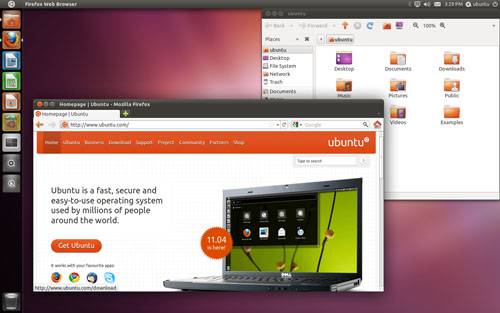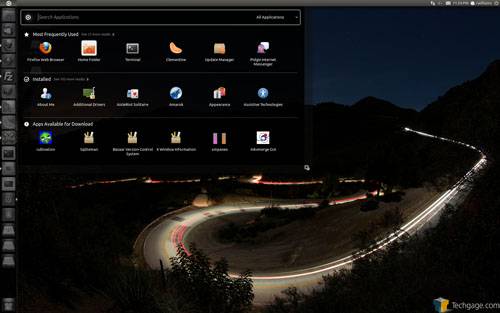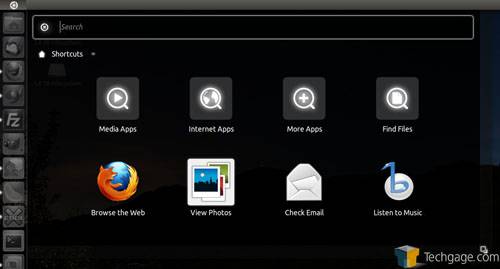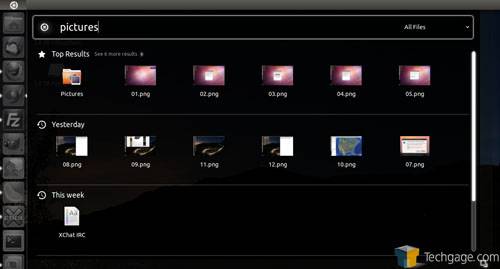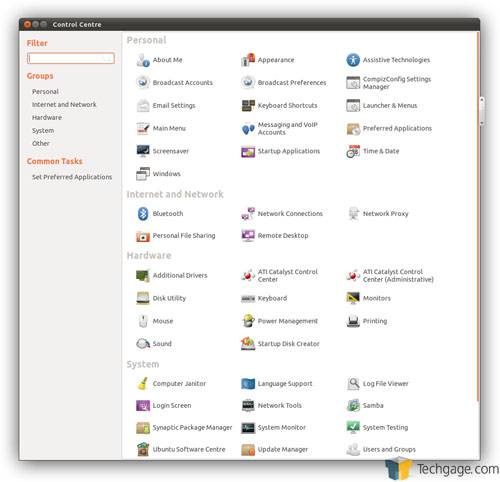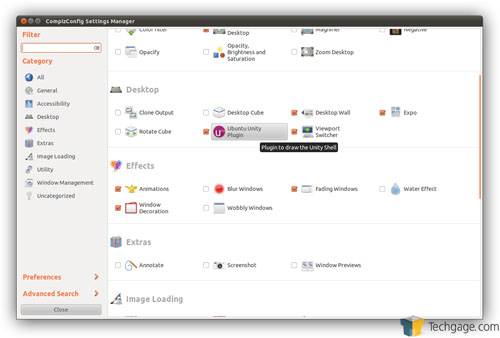- Qualcomm Launches Snapdragon 4 Gen 2 Mobile Platform
- AMD Launches Ryzen PRO 7000 Series Mobile & Desktop Platform
- Intel Launches Sleek Single-Slot Arc Pro A60 Workstation Graphics Card
- NVIDIA Announces Latest Ada Lovelace Additions: GeForce RTX 4060 Ti & RTX 4060
- Maxon Redshift With AMD Radeon GPU Rendering Support Now Available
An In-Depth Look at Ubuntu 11.04
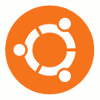
After months of anticipation, Ubuntu 11.04, codenamed ‘Natty Narwhal’, has launched in its final form. The big news this time around is that the OS ships with Canonical’s ‘Unity’ desktop environment as default – a large risk on behalf of the company. To see if that risk paid off, let’s take an in-depth look to see what Unity’s made of.
Page 3 – The Unity Desktop Environment
When Canonical first released its “Netbook Edition’ with its Unity desktop, I didn’t think much of it. I liked the look, and the overall goal, because after all… netbooks are short on screen real-estate, so to design a UI based around maximizing the space available sounded great to me. It never struck me as an environment I wanted to use myself, but I could see the potential, and understand why some people would enjoy it.
If someone asked me last summer if I could picture Unity on the desktop, I think I would have laughed. Well, joke’s on me, because it’s here, and barring any unforeseen occurrence, it’s here to stay.
In moving from the netbook version of Unity, Canonical made some rather significant upgrades, and while it is an environment that aims to optimize screen real-estate, I am not sure it’d be fair to call it a “netbook interface”. After all, no one calls awesome, dwm or Fluxbox a netbook environment, and they’re about as minimal as it can get.
On the surface, Unity looks a lot like GNOME 2.x, and that’s because it’s in effect, a shell interface that sits on top of a GNOME base. That makes Unity a GTK+ environment, and should it render GTK+ applications just as they run in GNOME. For the most part, this has been my experience, although I have a couple of caveats to mention on the last page of this article.
As you can see in the above screenshot, Unity foregoes a bottom-mounted taskbar like KDE, and also the menu-driven application/settings menu of GNOME. Instead, almost all activities start with this taskbar, from launching applications, to finding files, to finding new software to install. You can also click the workspace-changer icon to be given an overview look of your active workspaces.
The taskbar isn’t too cutomizable, with certain icons not being able to be removed at all (the bottom three in the above screenshot are static), and others not being able to be manipulated too well. For example, if an application is open, you’ll be unable to click and drag the icon for it anywhere on the taskbar. Only once you close the application you’ll be able to do that seemingly basic task.
Similar to Windows 7, you can create “Launchers” with installed software to keep a static icon of your favorite applications nearby at all times. Then, once an icon is clicked, the application is launched and then becomes that icon. The number of windows open related to that particular app will be denoted with small triangles on the left side, and an active application will be denoted with the same kind of triangle on the right side.
In lieu of a menu for finding applications to launch, Unity implements a pop-up that showcases everything within a bubble. It can be accessed by clicking the magnifying glass icon with a + sign, or hitting Windows Key + A. Here, applications can be searched for or located through menu navigation. If an application you search for isn’t installed, but is available for immediate download, a section called “Apps Available for Download’ will appear, where you can simply click on the icon of the application and be brought to that package in Ubuntu’s Software Centre.
This pop-up, while nice-looking, isn’t going to be considered efficient by a lot of people. It’s a lot easier to load up a quick menu and go look for an application there, rather than be given the six most recent applications you’ve launched, and then need to search for the rest. Also, the “Apps Available for Download” section serves little purpose. If the applications listed here were recommended by the community, that’d be one thing, but as far as I can tell, there’s no rhyme or reason for what gets listed here. Why exactly would a regular user want to download “X Window Information” out of the blue, for example?
For quick activities, there’s also the “dash”, which can be accessed by clicking the Ubuntu logo in the top-left corner, or hitting Windows Key + Q.
The icons found within are self-explanatory, with the bottom row being based on the default applications set. For example, if you set Google Chrome to be your preferred Web browser (in the “Preferred Applications” section in the System Settings), or Clementine to be your default audio player, the icons there would reflect that. For the sake of this screenshot, I simply left all of that default.
Finally, there’s the finder, which can be accessed by clicking the magnifying glass icon with a document inside of it, or hitting Windows Key + F. Here, you can search for any document by type or name, and as long as what you’re looking for is in a folder being indexed, it should pop right up here. I didn’t add my regular documents folder to the indexer, so all that shows up is what I have under my /home/ folder (which as you can see, includes pictures for this review).
If you’re familiar with GNOME 2.x, then truth be told, Unity isn’t going to be too difficult to pick up. Most of the popular GNOME software remains in-tact, and even the configuration tools remain the same:
For those who are interested in tweaking their taskbar even just a little bit, you’ll need to go to the Ubuntu Software Centre and search for “Compiz”, where the “Advanced Desktop Effects Settings” (CCSM) will show up. Once installed, you’ll be able to launch the configuration tool through the “System Settings”, where the “Ubuntu Unity Plugin” lies. Inside, you’ll have a limited amount of customization options, but you’ll be able to tweak a couple of things you might like, such as to make the taskbar never disappear (the exact reason I searched for the tool in the first place).
The fact that this configuration tool doesn’t ship with 11.04 blows my mind, because it’s the only way anyone can configure the taskbar at all. When beta 2 was released, it quite literally took me more than an hour to figure out how to gain access to the tweaking options, and while I do believe it’ll be easier for people to find this information now that the final is out, there’s no excuse for the tool not being pre-installed. The argument of stability could be raised, but if adjusting options for Unity isn’t stable, I wouldn’t think Unity would be, either.
Now would be a good time to also mention that Unity takes full advantage of Compiz compositing, so in effect, the entire environment is being accelerated by your graphics card, similar to both KDE 4 and Windows 7. For some reason, Canonical made Compiz a default option, so on some PCs, the performance might be super-sluggish if you don’t have the hardware to back it up. On my two-year-old netbook, the interface is a bit slow, but it’s nothing major.
For those who don’t have the GPU brawn to power Unity in its default state, a 2D version can be installed through the software centre. And it should also be noted, that if you for any reason can’t stand Unity, you can simply log out and choose to log into “Ubuntu Classic”, which will bring you to the usual GNOME 2.x desktop.

Another interesting change with Unity is what you see above. Rather than use the standard scrollbar for GTK+-based applications, Unity leaves a thin line, with orange representing the part of the “page” you’re at. It’s only when you hover over the edge of an application that requires a scroll when the up and down arrow appears. This is yet one of those ways where the Ubuntu devs figured out a way to save even more screen real-estate, and for the most part, I think it’s a great feature. There have been problems though, where I’d be trying to access text under it in my HTML editor where it definitively blocked my way, but working around that was easy enough.
There is a lot more to Unity than just what I’ve mentioned on this page, but for the sake of time, I’ve just covered the most notable features. With that said, let’s get into my final thoughts.
Support our efforts! With ad revenue at an all-time low for written websites, we're relying more than ever on reader support to help us continue putting so much effort into this type of content. You can support us by becoming a Patron, or by using our Amazon shopping affiliate links listed through our articles. Thanks for your support!




